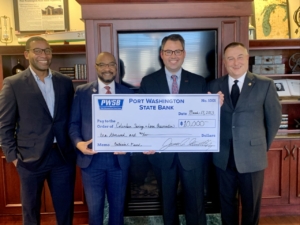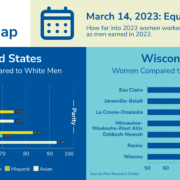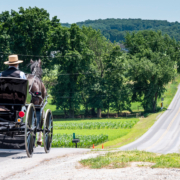Columbia Savings & Loan Association Positively Impacts Black Communities, Banking Industry
Wisconsin’s first Black-owned bank nears 100 years of service
By Hannah Flanders
 In 2024, Columbia Savings & Loan Association, Wisconsin’s first — and currently, only — African American-owned bank, will reach 100 years of service. The institution primarily serves low- and moderate- income families of Milwaukee County. Since 1924, the institution, founded by Ardie and Wilbur Halyard, has prioritized providing access to capital to members of its community.
In 2024, Columbia Savings & Loan Association, Wisconsin’s first — and currently, only — African American-owned bank, will reach 100 years of service. The institution primarily serves low- and moderate- income families of Milwaukee County. Since 1924, the institution, founded by Ardie and Wilbur Halyard, has prioritized providing access to capital to members of its community.
Now led by Ernest Jones and Will Martin, Columbia Savings & Loan Association — the sixth oldest Black-owned bank in the U.S. and oldest Black-owned bank in Wisconsin — continues to see its mission to ensure low- to moderate-income families have access to capital where others may see risk.
Black-owned Banks in America
Like all banks, the history of Black-owned banks in America is storied and complex. The first Black-owned bank — True Reformers Bank — was founded in 1888 in Richmond, Virginia. While the bank didn’t open until April of the following year, narrowly following the opening of Capital Savings Bank in Washington D.C. in October 1888, True Reformers operated in 24 states and spearheaded the idea of closing the racial wealth gap. Although True Reformers Bank closed in 1910, by 1934, the number of financial institutions owned by people of color numbered over 130.
According to the Federal Reserve Bank of Chicago, only nine Black-owned banks — including Columbia Savings & Loan Association — remained in business during the Great Depression. During and following the civil rights movement of the 1950s and 1960s, which encouraged Black individuals to empower themselves, Black-owned banks throughout the U.S. again experienced growth. In 1970, the Department of the Treasury began the Minority Bank Deposit Program, which would help strengthen and preserve minority-owned banks. One year later, in 1971, North Milwaukee State Bank was chartered.
In addition to the pressure Columbia was facing as one of 50 Black-owned banks nationwide, the institution also was severely impacted by the savings and loan crisis of the 1980s. The disaster, caused by excessive lending and taxpayer bailout guarantees, claimed nearly 45 of Wisconsin’s savings and loan associations and 35 Black-owned banks across America. Although Columbia Savings & Loan endured, the Federal Reserve Bank of Chicago (FDIC) notes that losses caused by the crisis fell disproportionately on to the minority-owned sector.
At the turn of the 21st century, Milwaukee welcomed Legacy Bank as its third Black-owned bank. However, the Great Recession of 2007–2009 claimed both Legacy Bank and North Milwaukee State Bank, and only 23 Black-owned banks, including Columbia Savings & Loan, remained throughout the country.
While many Black-owned banks continue to recover from the obstacles of the last several decades, the need for institutions willing to invest in low- to moderate-income communities is becoming even more critical.
Ingrained Discrimination
When Columbia Savings & Loan Association began operations in January 1925, the beginnings of redlining were just emerging in Wisconsin. Published in the Milwaukee Journal just months before, members of Milwaukee’s Board of Realtors discussed the development of a City Negro District or “Black Belt,” restricting housing for Black residents to the west side of Milwaukee. Ultimately, the concept of racially based redlining was implemented, and thousands of Black families were forced to live within a concentrated space of fewer than 40 blocks. This discrimination in housing remained solidly in place until the Civil Rights era, when the Fair Housing Act of 1968 was signed into law.
As time progressed, and the Federal Housing Administration (FHA) was created as part of President Franklin D. Roosevelt’s New Deal and the National Housing Act of 1934, home affordability for people of color became even more difficult. With the FHA identifying low-risk neighborhoods as predominantly white communities, white families had the ability to access inexpensive, insured mortgages that allowed them to move to suburban areas and build the generational wealth to start businesses or enroll in college.
On the other hand, minority populations across the U.S. were segregated into urban neighborhoods where FHA-insured mortgages were not available. With lower home values and less homeowner wealth to be reinvested into repairing aging homes or starting new businesses, cities struggled to expand their schools and other infrastructure.
Unfortunately, the poverty cycle continued, making it difficult for individuals to qualify for mortgage loans. Legislation such as the Fair Housing Act of 1968 was enacted into law to protect people from discrimination when engaging in housing-related activities such as renting or buying a home. The Brookings Institution suggests that “channeling the flow of [credit] to specific neighborhoods and demographics is key, as across-the- board increases in [credit] supply to all racial groups lead to the growth of urban segregation.”
Columbia Savings & Loan is keenly aware of its unique ability to help local individuals and families buy homes, fund businesses, and build places of worship. Located in the heart of Milwaukee’s Amani neighborhood and serving communities living in Wisconsin’s poorest ZIP code, Columbia Savings & Loan Association has been dedicated, from the very beginning, to helping strengthen the surrounding neighborhoods by helping families gain and sustain the capital necessary to own their own homes.
“We see ourselves as a bank that makes a social impact,” states Will Martin, Columbia Savings & Loan Association’s executive vice president. “With the community fabric in many of our neighborhoods being torn away, many of the families that approach us are seeking a place where they will be respected and understood. These individuals are commonly intimidated by the financial sector or have not had success in the past with other lenders — it is our responsibility to, in a culturally respectful manner, find a solution that best serves their needs.”
Shaping Milwaukee
As Forbes highlights in an article titled “Black-owned Banks Are Key to Lifting Economic Fortunes of Black Communities,” Black-owned banks have historically held an in-depth understanding of the disenfranchised communities they serve. These banks have the unique ability to introduce many un- and underbanked communities — including 54.8% of Black households, according to the Federal Deposit Insurance Corporation’s (FDIC) 2021 National Survey — to the financial sector. In addition, many minority-owned banks have made capital more accessible to low- to moderate income populations as they commonly approve a higher percentage of loans to Black applicants.
The Independent Community Bankers Association (ICBA) echoes this sentiment in its article, “Why We Need Black-owned Banks.” The article states that, in order to begin closing America’s racial wealth gap, it is necessary that our society strengthens the institutions dedicated to making a positive impact on underserved and underbanked communities.
“A diverse banking sector is critical to meeting the unique needs of our diverse country,” states WBA President and CEO Rose Oswald Poels. “Banks such as Columbia Savings & Loan Association play a unique role in integrating individuals into the financial sector and providing them with the resources for financial security. By equipping all banks to economically empower disenfranchised individuals, we are ensuring that all banks, and their surrounding communities, succeed.”
As the bank has largely been credited for the development of the Halyard Park neighborhood — named for the founders of Columbia Savings — the institution is dedicated to helping residents of Milwaukee obtain mortgages.
As of March 2023, only around 29% of Black individuals throughout Wisconsin owned their own home, according to the National Association of Realtors. While homeownership remains low among all people of color, Black individuals have a higher likelihood of facing disadvantages such as appraisal bias and loan denial.
“As banking attorney for Wisconsin’s Department of Financial Institutions (DFI), I had the sorrowful task of helping close one of the two Black-owned banks Milwaukee lost in the wake of the Great Recession and vowed to do all I can to preserve Columbia Savings & Loan Association,” explained Ernest Jones, Board Chair and CEO. “Homeownership is the first step toward building generational wealth, and Columbia has helped thou-sands of families achieve that first step. However, with seven out of every ten Black families in Wisconsin renting — often at greater expense than owning — our community needs Columbia Savings & Loan Association more than ever.”
Looking Ahead to the Next Century
Looking ahead, Martin emphasizes the benefit of partnerships throughout the industry.
“In our first 100 years, Columbia focused on building personal relationships; walking with our customers through their challenges,” says Martin. “In this new century of service, we hope to amplify our impact and serve exponentially more families by leveraging technology.”

Port Washington State Bank was the first financial institution to make a contribution toward Columbia’s Centennial Fund. Additional contributions from several others are currently pending.
As such, Columbia Savings & Loan Association announced in February 2023 its Centennial Fund. With Columbia’s growing role in its community, the fund is a means for financial institutions and other corporations to help the bank through non-depository funding to modernize operations, digital infrastructure, and staff training, in addition to helping to increase the impact Columbia has on the local, underserved community. At the time of this writing, the bank has raised over $50,000 in corporate contributions and more than $2 million in new deposits which, according to Martin, will help up to 25 low- to moderate-income families buy homes and take the first steps towards their financial security.
“Like all banks, Black and minority-owned institutions are subject to intense regulatory burden and challenges in attracting talent,” says Oswald Poels. “However, these institutions also lack access to capital and are subject to the changing urban demographics. It is critical for the continued success of these institutions and the communities they serve that we all consider the ways in which we can assist banks like Columbia Savings & Loan in gaining the capital they need to reinvest and help empower disenfranchised individuals.”
Centennial Fund
In February 2023, Columbia Savings & Loan Association announced its Centennial Fund. The fund is a way for financial institutions and other corporations to help the bank through non-depository funding to modernize operations, digital infrastructure, staff training, and to also help increase the impact Columbia has on the local, underserved community.
The $50,000 in corporate contributions and more than $2 million in new deposits raised so far, will help up to 25 low- to moderate-income families buy homes and take their first steps towards financial security. For more information on how you can partner with Columbia Savings & Loan Association, Wisconsin’s only Black-owned bank, contact Will Martin at 414-374-0486, or WMartin@ColumbiaSLA.com.







